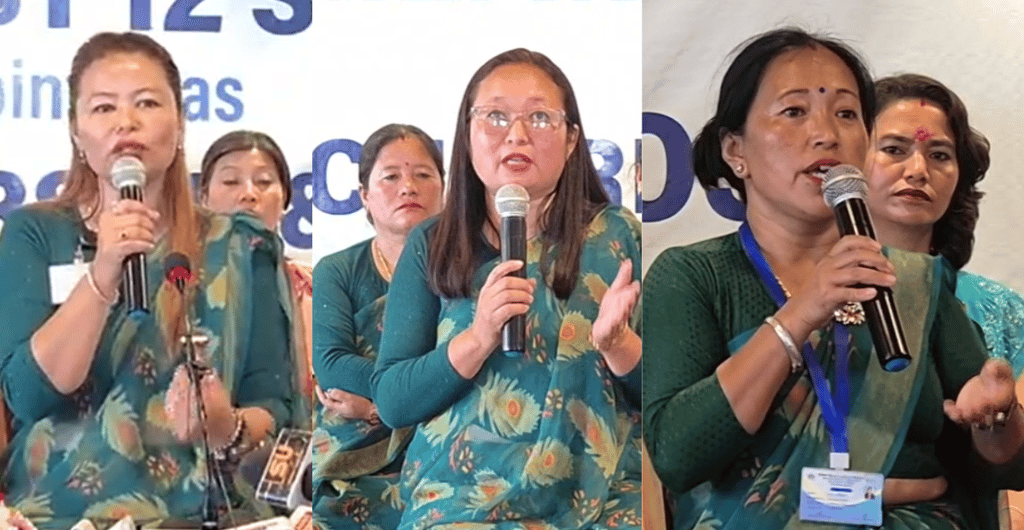12 SHG women appointed Chairpersons and OSDs by Sikkim government in historic empowerment
It all began with a major event held on March 3, 2024, at Ralong Playground, where thousands of SHG members gathered for a historic convention. It was there that the Chief Minister made the unprecedented announcement — to appoint 12 women from SHGs to key positions within the government system.
LOCAL


In a historic move towards women’s empowerment and grassroots leadership, the Government of Sikkim has appointed 12 women leaders from Self-Help Groups (SHGs) as Chairpersons and Officers on Special Duty (OSDs) across various departments. This decision, under the visionary leadership of Chief Minister Prem Singh Tamang (Golay), is being hailed as a major milestone in Sikkim’s political and social history — especially in a state where women’s representation has long been a subject of public concern and criticism.
The appointments were not sudden. They were the outcome of years of dedicated work by SHG women across Sikkim and a structured vision under the Livelihood Department’s mission for self-reliance and empowerment. It all began with a major event held on March 3, 2024, at Ralong Playground, where thousands of SHG members gathered for a historic convention. It was there that the Chief Minister made the unprecedented announcement — to appoint 12 women from SHGs to key positions within the government system.
Speaking at the press meet held recently, one of the appointed leaders said, “We would like to express our heartfelt gratitude to the Sikkim Government and our most respected, honourable, and esteemed Chief Minister. This outcome is not just about us 12 women. It is the recognition of thousands of women across Sikkim who have worked silently through SHGs for years.”
She emphasized how the SHG movement in Sikkim, which now comprises over 55,000 women, has become not just a support system but a platform for leadership, independence, and identity. “Before, women were dependent — on fathers, brothers, or husbands. But now, SHGs have helped women become financially independent and confident,” she added.
Another newly appointed Chairperson recounted her long journey with SHGs since 2005, when she first joined the group. “Earlier, there was no discipline. Money was collected but no one knew how it was used. But after 2017, we started learning about bookkeeping, savings, internal lending, and building trust. That changed everything,” she said. She also credited the Panchasutra (five key principles) of SHGs as a transformative tool that brought about discipline and accountability in their functioning.
Importantly, she highlighted how SHGs slowly evolved into economically productive units. “We even got two stalls in MG Marg market. Now our products are being sold. Our husbands, who once didn’t believe in our work, now respect us. This is a big change.”
The emotion and pride in these women's voices were unmistakable. A third woman expressed her gratitude by saying, “Previously, many of us stayed behind the curtain. But today, because of the Chief Minister’s support and the encouragement of our SHG sisters, we are here — in front of you. This is not just our victory; it’s a win for every woman in Sikkim.”
She went on to explain how small savings of ₹10 and ₹20 collected by women over time have now turned into community funds, support systems, and even small enterprises. “Our women, who once only did household chores, now run businesses. This is a new Sikkim,” she added with pride.
According to data shared, India has over 90.90 lakh SHGs with 10.05 crore women members, many of whom have benefitted from schemes similar to Sikkim’s model. The state’s decision has drawn national and even international attention as a model for grassroots women’s empowerment, especially relevant for countries in South and Southeast Asia, where such models are still developing.
The appointed women emphasized that these positions were not just symbolic but carried heavy responsibilities. “We accept this responsibility with humility and dedication. Our aim now is to reach the last woman in the last home and ensure that no one is left behind,” said one of the Chairpersons.
Each woman shared that SHGs had become a force not just for economic progress but also for social unity, skill development, and political participation. Many credited Sikkim Rural Livelihood Mission (SRLM) and the Livelihood Department for providing technical and emotional support over the years.
The list of newly appointed Chairpersons and Officers on Special Duty (OSDs) includes 12 women from diverse backgrounds, representing different regions and communities across all districts of Sikkim. These women have been placed in key government departments, reflecting not only inclusivity but also the state’s commitment to grassroots leadership. Ms. Ongkit Lepcha has been appointed as Chairperson of the Horticulture Department, while Chumila Bhutia now serves in the Public Health Engineering Department (PHE). Lilly Rai takes charge of the Agriculture Department, and Nim Chiki Sherpa has been appointed to the Commerce and Industries Department. Bidya Biswakarma will lead the Cooperation Department, and Khus Maya Tamang has been given responsibility for the Water Resources Department. Kala Pradhan has been entrusted with the Department of Food Processing Industries, while Doma Lepcha has taken over the Animal Husbandry & Veterinary Services Department. Shanti Limboo now leads the Sikkim Consumer Cooperative Society, and Mingma Lhamu Sherpa will work with the Capacity Building, Skill Development Training, Youth Empowerment and Self-Reliant Board. Anuradha Gurung has been appointed in the Fisheries Department, and Indra Kala Chettri will serve as Officer on Special Duty (OSD) to the Department of Panchayati Raj. These appointments mark a significant step forward in women’s participation in governance and administrative leadership in Sikkim.
